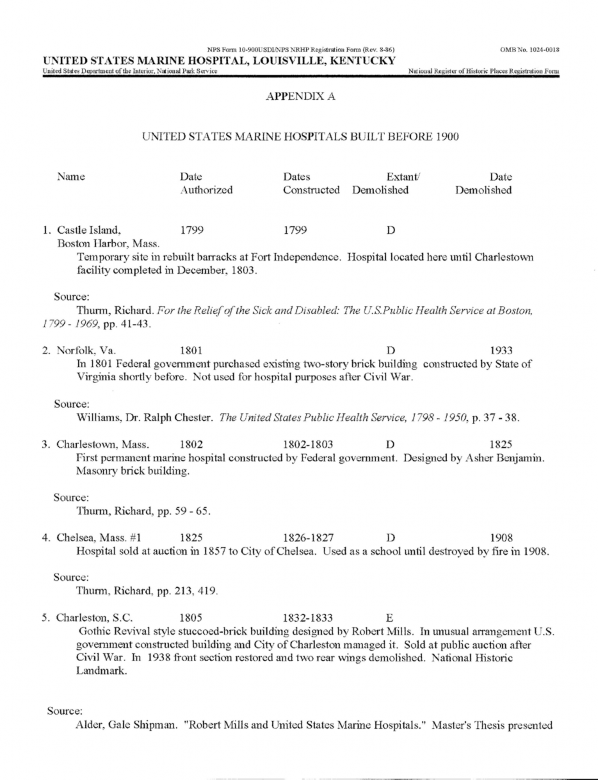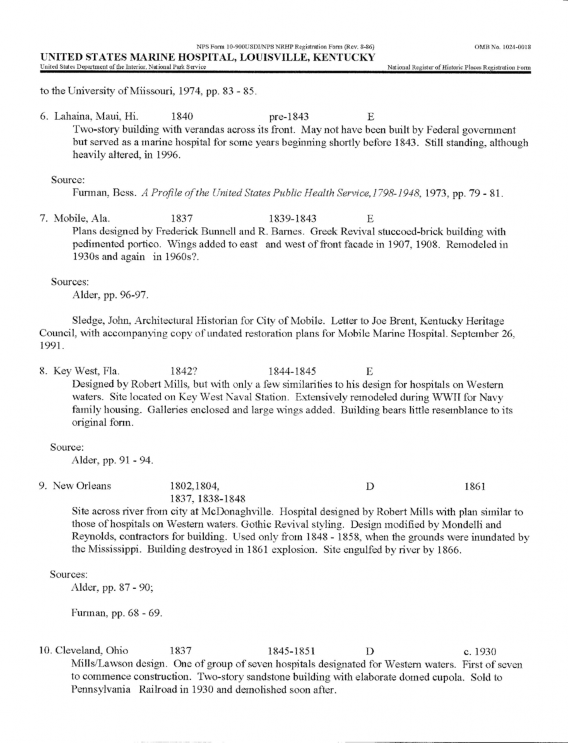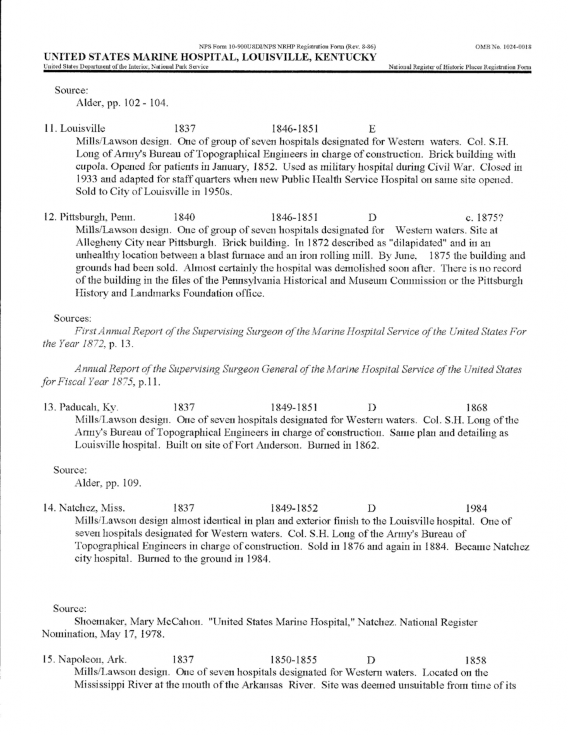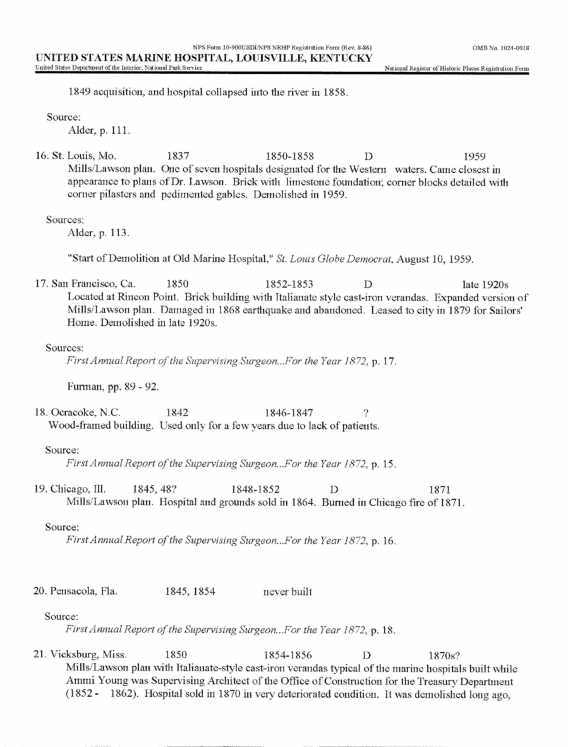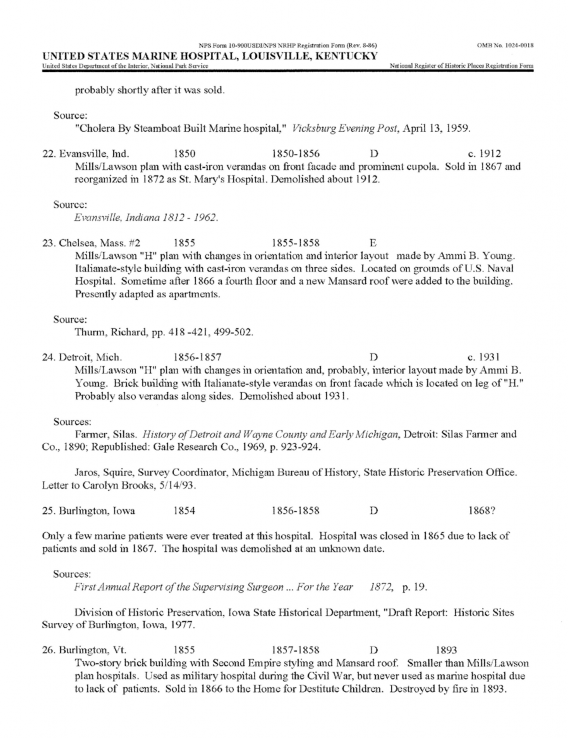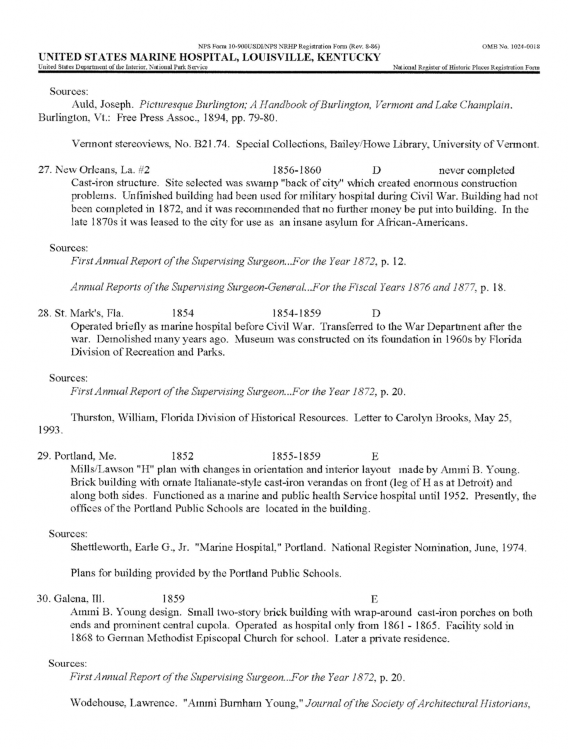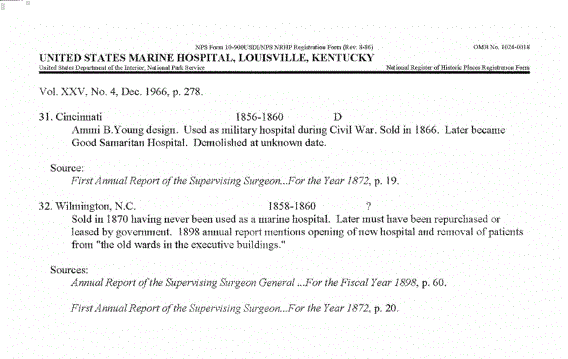
The Marine Hospital 1859-2020
Researched and written by Dr. Daryl Watson for The Galena Foundation
November, 2020
Cover photo showing the front facade of the U.S. Marine Hospital, looking east. Photo taken in 2017 by Ken Robb.
In September of 1844, the City of Galena made its first attempt at establishing a Marine Hospital. Such hospitals were not new. An act calling for the establishment of a system of hospitals along the East and Gulf coasts was passed by the U. S. Congress in 1798 and signed by President John Adams. It provided for the care of sick or injured sailors (the term then used was seamen) and was funded by both the federal government and a 20 cents per month deduction on the wages of all employees of the river and ocean vessels of the time (http://www.marinehospital.org/past.htm retrieved 4 October 2020.)
Marine hospitals had nothing to do with the U.S. Marine Corps; they were for the sailors of the oceans and later for the boatmen of the interior waterways, many of whom had no access to healthcare, despite the importance of their occupations to the economic health of the nation. It was America's first entry into socialized health care.
The hazards of life on the water were many: there were boiler explosions, wrecks, collisions with river snags, and diseases like malaria, cholera, yellow fever and smallpox. Violence, alcoholism and social diseases were also rampant. As America moved westward and steamboat traffic on the inland waters increased exponentially the need to expand the program beyond coastal cities became apparent. Galena, the largest river port north of St Louis by the 1840s, saw the need, especially since New Orleans, St. Louis and Louisville already had such facilities.
The City Council in September of 1844 dutifully passed a petition directed to the United States Senate and House of Representatives asking for consideration in the establishment of such a hospital(s) for their city. Their case was presented in a brief and forthright manner, but with a novel funding system, based on the precedent of funds from the sale of Section 16 of every township to be used to fund public schools:
...in this County and vicinity there are upwards of Fifteen Thousand persons engaged in mineing [sic] operations on the Public Domain - That they are generally men without families and necessarily suffer many privations...
That the City of Galena is the head Commercial Emporium...of General Steam boat navigation - being some five hundred miles above Saint Louis....would therefore in view of the necessity as well as the advantages to be derived - Respectfully pray Congress to Grant to the City of Galena by legal subdivisions One Town[ship] of land to be appropriated or disposed of in erecting Marine and City Hospitals....Appropriating one part of said edifice where erected as a Marine Hospital of the United States and the other as a City Hospital. (Copy housed at the Galena Public Library, Historical Collections Room, City of Galena files).
There is no record of any action being taken on the federal part of the proposal. It could be that Galena did not have a strong enough voice in the U. S. Congress. These hospitals--some of which were temporarily rented, leased, or in private homes--were
mostly under local control and funding was provided by the aforementioned tax in conjunction with federal appropriations, all under the supervision of the Department of the Treasury. Put another way, these hospitals were largely in the hands of politicians and local customs officials--as was the case when Galena soon got its marine hospital.
But Galena's effort to get a hospital did not bear fruit until the election of a new congressman from Galena, Elihu B. Washburne, in 1852. It would be the shrewd and forceful Washburne who would soon establish a name for himself, Galena, and U. S. Grant (Figure 1).

Figure 1. Elihu B. Washburne - Powerful U. S. House Representative from Galena. Galena-Jo Daviess County History Museum.
According to the National Register nomination for the Marine Hospital at Louisville, Kentucky, seven hospitals were authorized by an Act of Congress in 1837 for the "Western Waters" (https://npgallery.nps.gov/GetAsset/deee98e1-1ddb-42e5-b73f- 822958607ab9, pp. 8-12, retrieved 10 October 2020). Galena was not among them, but it was included in a second Act of Congress, passed 17 years later. Interestingly, of the hospitals constructed along inland waterways during this period prior to the Civil War, only the Louisville and Galena hospitals remain today. (See Appendix A.)
The Galena Weekly Northwestern Gazette reported the following in 1854:
On the 30th ult., a resolution was offered in the House of Representatives by Mr. WASHBURNE instructing the committee on Commerce to inquire into the expediency of establishing a Marine Hospital at Galena. The resolution was instantly passed. (Weekly Northwestern Gazette, 14 February 1854.)
The paper's editor later addressed reasons why such a hospital for boatmen on the inland waters was so vital for Galena and its river trade (See Figure 2):
There is no point in the country where a Marine Hospital is more needed than in this city. Our commerce has increased to such an extent within a few years, that Galena is now the third port, in point of Tonnage and Shipping on the Mississippi River. New Orleans and St. Louis being the only ports in advance of Galena at the present time. We learn that there are twenty-two steamboats now owned and enrolled here, and about one thousand seamen hailing from Galena. The whole number of boats in the Galena trade during the past season is about forty, and there have been within that time, one thousand arrivals of boats and barges at this port. These facts show not only the great want of a Marine Hospital here, where the large number of sick boatmen can be cared for, but a most gratifying state of things as connected with the prosperity of our city. (Weekly Northwestern Gazette, 27 November 1855.)

Figure 2. 1856 lithograph by E. Whitefield. This is a very accurate portrayal of the Galena levee during the height of the town's prosperity. Galena-Jo Daviess County History Museum.
Good news had come earlier in the year when the editor of the Weekly Northwestern Gazette announced with some pride that an "agreeable" letter from Galena's "faithful Representative in Congress" had just arrived:
DEAR SIR: I have the pleasure to inform you, that a bill has just passed, making an appropriation of FIFTEEN THOUSAND DOLLARS FOR A MARINE HOSPITAL AT GALENA.
Yours, in haste.
-
B. WASHBURNE (Weekly Northwestern Gazette, 13 March 1855.)
But delays and hurdles yet remained. A plot of land near the city limits, but not within, had to be found. And it had to be "convenient to the Steamboat Landing" (Weekly
Northwestern Gazette, 27 March 1855). It also had to be between 10 and 20 acres in size.
Another sticking point was ownership. The parcel had to be ceded by the state legislature--rather than a private landowner--to the federal government.
The project was delayed, but finally the slow wheels of legislative action began to turn and the November 12, 1856 Galena Daily Advertiser could report the following good news:
The secretary of the treasury has selected...a site for this building, which he purchased from Michael McCarty, Esq., for the sum of
$5,025... steps will be taken for the prosecution of the work as soon as the legislature of the state cedes jurisdiction to the government.
Three months later the contract was let and a description of the new building, designed by one of America's most notable government architects, Ammi B. Young, was revealed to the public (Figures 3, 4, 5): (Library of Congress--Retrieved 9 September 2020, http://www.loc.gov/pictures/search/?q=Galena%2C%20IL%20Marine%20Hospital.)
The building will be of brick, 50 by 55 feet and two stories high, above the cellar story, and will be surmounted with a spacious belvedere.
The basement or cellar story will be ten feet high, and contain kitchen, laundry, Fuel and Furnace Room, Meat and Vegetable Room, Family Dining room, Hall, bedrooms, etc.
The Entrance Story will be thirteen feet in height, and contain a Dining and Sitting Room for convalescents, Office, Family Parlor, Bedroom, Hall Vestibule, Bath Rooms and closets.
The Second Story will be fourteen feet high and be divided into three large Wards for the inmates of the Hospital, to which will be attached the Dispensary, and suitable number of Bath Rooms, etc.
Verandas 6 1/2 feet wide will extend around the building, on a level with the first and second story floors, and underneath them will be a sink area of the same width.
The under pinning of the whole building, the steps, curbs, sill, etc. are to be of the best limestone or marble. The walls above the foundation will be of brick. The caps of the outside doors and windows of the 1st and 2d stories, the columns, capitals, &c. of the verandas, the piers of the balustrade, and the consoles of iron. The railing of the verandas will be of wire work. The roof of the building and of the verandas will be of iron, as will also the stairways which will lead, continuously from the cellar to the belvedere and hot-air furnace will be put up in the cellar to heat the whole building. Fireplaces will also be constructed. The building will be lighted with one hundred windows. The exterior iron work will be painted in imitation of granite, and the interior in imitation of bronze. Cisterns will be constructed upon the premises having a capacity, of 30,000 gallons. (Galena Daily Advertiser, 10 March 1857).

Figure 3. Marine Hospital Front and Side Elevations. Historic American Buildings Survey - Library of Congress.

Figure 4. Marine Hospital Entry and Second Story Plan. Historic American Buildings Survey - Library of Congress.

Figure 5. Marine Hospital Section Drawings.
Historic American Buildings Survey - Library of Congress.
Almost the entire building was of cast iron and brick, with wood only for doors, trim and some of the floors. This was a new and novel type of construction. The ceilings were a series of brick vaults, with horizontal cast iron beams supporting the brick. The brick was then plastered. It should be noted that exposed brick on interior walls was rarely a part of early American architecture (Figure 6).

Figure 6. Marine Hospital showing unique vaulted brick ceilings supported by iron beams and then covered with lath and plaster. Note also the vents in the interior brick wall which opened into a four inch space between the interior and exterior walls. - Neg. # 3 - Galena State Historic Sites Office.
The Marine Hospital also had a novel way to avoid dampness and drafts inside its brick walls. There were actually two--almost twelve inch thick--walls with a 4-inch gap between them. This permitted ventilation, aided with a series of grates through the inner wall that could be opened or closed. The effect was to moderate both cold winter temperatures and hot summer temperatures.
And the central cast iron stairway that climbed from the basement to the belvedere was a masterpiece. Similar to the one in Galena's U. S. Post Office, it differed by having as ornamentation a mariner's theme, with a continuous band of whales and shells motif along the length of the fascia (Figure 7). The railing is solid mahogany.

Figure 7. Marine Hospital's Elegant Iron Staircase with whale and shell motif on fascia. Mahogany railing topped the iron balusters. - Neg. 27 - Galena State Historic Sites Office.
It should be noted that, due to Congressman Washburne's efforts, Galena was getting another new government building at the same time, a combination U. S. Custom House and Post Office, still in use today. Ammi B. Young was also the architect for this latter building, perhaps the oldest still in use in the country (it was designated by the Smithsonian as the second oldest, over 20 years ago). As Supervising Architect for the Department of Treasury, Young designed a multitude of government buildings.
Both the Custom House/Post Office and Marine Hospital were built at the same time and the engineer in charge of construction for both was the Seneca Indian, Ely S. Parker, who became U. S. Grant's personal secretary during the Civil War. The person in charge of disbursements, subject to approval by the U. S. Treasury, was Galenian Daniel Wann, Surveyor of Customs. Formerly engaged in the mercantile business, he was meticulous in his attention to detail.
Ground was broken for the new hospital in April. It was a low key affair. The paper reported the occasion as follows:
Yesterday morning, workmen broke ground for the foundation of the Marine Hospital. The contractors, Messrs. Gager and Joyce...for their friends, who were called to witness the operation, prepared a generous table of refreshments...over which, from a vigorous oak sapling raised for the occasion, floated the ever glorious stars and stripes. (Galena Daily Advertiser, 24 April 1857.)
It's uncertain if the "vigorous oak sapling" was cut and raised for the occasion, or whether they simply used a live tree; the giant white oak tree standing behind the hospital today would have been a fine young tree at the time (Figure 8).

Figure 8. Marine Hospital's giant white oak tree - Neg. 22 - Galena State Historic Sites Office.
Construction progress did not go as rapidly as first hoped. A suitable pressed brick could only be found from one manufacturer in Dubuque (Galena Daily Courier, 25 April 1857). And the stone the contractor had to dig through was also a problem. An official report prepared by the Chief of the Construction Bureau of the Treasury Department noted the progress--and delays--of construction of the hospital:
The causes which have retarded its progress, principally, are the same difficulty in procuring stone as was experienced at the neighboring city of Dubuque, as the stone had ultimately to be brought from Nauvoo; and the great difficulty in procuring suitable bricks. The excavations of the cellar and cisterns had to be made through rotten rock instead of stone, as it was supposed. These difficulties have been overcome; the sub-foundation walls are all laid, the main drain constructed, small cistern, containing 10,000 gallons, built and covered; excavation of a large cistern made, underpinning stone cut and ready to be set, door and window frames, sashes and doors and portion of the inside mouldings, are finished. It is hoped that the walls of the cellar and large cistern may be completed this season. (Weekly North Western Gazette, 19 January 1858.)
It had already been determined that stone for the foundation would come from the quarries at Nauvoo, Illinois. These quarries, which had been used by the Mormons to build their first temple, were visited by Ely Parker, who noticed their superior quality stone. He authorized their use for both the Marine Hospital and Custom House/Post Office.
It should be noted that even before the Marine Hospital was finished in 1859, the U. S. Treasury Department had authorized Daniel Wann, Surveyor of Customs and Agent for the Marine Hospital, to care for sick and disabled boatmen by housing them in private homes. For the month of October, 1857, for example, seven of them were treated and
released for a cost to the government of $176.64 ("Moneys received and expended by Daniel Wann, U. S. Treasury Document," The National Archives, No. 128. Copy in the Marine Hospital file of the Galena State Historic Sites office). In all some 41 boatmen were cared for in this way, most for relatively minor complaints. All were released after care and treatment.
Meanwhile, work on the Marine Hospital continued and was completed, largely on schedule, in October of 1859 (Figure 9). A letter dated October 31, 1859 from the Treasury Department summarized the expenses: Construction, including cost of land --
$48, 203; Fencing the grounds (all 11 acres) - $2200; and $1377 for furnishings (Letter
#46, Treasury Department, copy in Marine Hospital file housed at the Galena State Historic Sites office). The editor of the Daily Courier thought its "fine architectural appearance, beautiful location, and spacious grounds" would make it a "favorite point for pleasure drives and promenades" (23 June 1859). On a more practical note, he reported that the building could accommodate 40 to 50 patients at a time. That capacity would never be reached (Figure 10).

Figure 9. Looking upstream with Flour Mill on left and Marine Hospital on right (circa 1860). This may be one of the earliest photos of the new hospital.
Alfred W. Mueller Collection - Galena State Historic Sites Office.

Figure 10. Marine Hospital near the end of German-English school tenure Alfred W. Mueller Collection - Galena Public Library.
The job of physician and surgeon was awarded to Dr. Horatio Newhall, one of Galena's earliest and most respected medical men. His salary was placed at $800 per year, the highest of anyone connected with the Hospital (Treasury Department Letter #46, March 30, 1861, copy in Galena State Historic Sites Office).
Hopes were high that Galena's new Marine Hospital would be not only a humanitarian success but a financial one as well. After it was up and running Elihu Washburne requested the Treasury Department to state whether the amount of Hospital money collected at Galena was "not comparatively larger than at other ports where Marine Hospitals were in Operation" (Letter #46). It wasn't. In fact, of 23 hospitals Galena ranked tenth from the bottom, and all of those ten were substantially below the larger hospitals.
It was also noted in the same Treasury Department letter (Letter #46) that during its first year of operation Galena's Marine Hospital treated (and released) forty-one patients. The cost for one week's stay was $3.00. The numbers only went down from there. Most patients stayed only a short time.
Over the years there have been persistent reports of multiple burials at the site. There is even a copy of a hand-written letter from the time period requesting the need for 200-300 coffins. But the evidence is not there. The signatures on the letter do not match any of those involved with the Galena hospital. There may indeed be a few burials at the site, but as mentioned above, the overwhelming majority of patients were short-term and there were never very many. Only the largest marine hospitals could account for those numbers, i.e. New Orleans, Louisville, Chicago.
The expenditures of the government to run the hospital far outstripped income. The reasons were many, but a river silting up, the Civil War and a blockade of the lower Mississippi, historic low water levels in 1864-65 that virtually closed the Galena River, and the competition of the railroads, all had devastating effects. With the end of the war, the handwriting was on the wall. It was hoped that sick and wounded Civil War soldiers might be sent to Galena, but it did not happen. Instead, larger and more accessible ports got that traffic: New Orleans, St. Louis, Chicago and Louisville.
At the end of the War, the Treasury Department, acting on congressional action, began closing low performing hospitals. Congressman Washburne at first resisted; he wrote a letter to the Secretary of the Treasury on August 11, 1865 stating: "But now there is a different state of things--the river is open all the way, we are likely to have a good winter, and the boating interests must be greatly stimulated" (Correspondence in the Marine Hospital folder, State Historic Sites Office).
Washburne also enclosed a petition from the boating interests imploring the Treasury Department not to discontinue the hospital at Galena, the only one north of St. Louis. It was signed by the Directors of all the largest lines running boats on the Upper River (St. Louis to St. Paul): the Lacrosse Packet Co., Minnesota Packet Co., Prairie du Chien Packet Co., and the Northern Line. (Correspondence in the Marine Hospital folder, State Historic Sites Office). Also signing were captains, engineers, and pilots. The Treasury Department reluctantly agreed to keep it open a few months longer, but to no avail.
The handwriting was on the wall; while expenses were kept low, the Galena hospital was tending to very few (and at times zero) patients. Washburne, always a pragmatist, shortly introduced a bill in the House providing for the closure and sale of a number of Marine Hospitals, including the one in Galena (clipping dated 12 February 1866 in the Marine Hospital files housed at the Galena State Historic Sites Office). After six years of service the hospital formally closed on December 31, 1866.
An editorial in the Galena Daily Gazette (6 January 1866) summed it up as follows:
...the marine hospital system of the country has on the whole proved a failure. It was established with the best and noblest intentions... The buildings for the hospitals were erected with great cost and admirably adapted to the purpose designed... But, after all, the number of patients were too few to warrant the expense...
Galena's few remaining patients were transferred to Chicago's marine hospital.
All furnishings and equipment were to be sold at public auction. A complete inventory of everything sold and the price it brought at auction was recorded by the Department of Treasury. A copy is in the Marine Hospital folder in the Galena Historic Sites Office.
Literally everything went: beds, stoves, tables, dressers, medicines, blankets, spittoons, silverware, curtains, shirts, etc. Sadly, most items went for pennies on the dollar. H. H. Chandler bought six parlor chairs for $4.30 each; Dr. Kittoe bought six cane chairs for
$2.00 each; J. Mahoney bought two trays and a pitcher for 35 cents; Dr. Crawford bought a case of instruments for $3.50; new shirts were going for 85 cents apiece; and the list goes on and on.
The building and grounds were advertised for public auction in April of 1867. Galena's
Weekly Gazette described the property in glowing terms (Figure11):
Its situation is one of the most picturesque that we have seen. The grounds contain about eleven acres...and are enclosed with a most substantial and beautiful picket fence, and it is well calculated for many kinds of nursery planting, for the raising of grapes, or for ornamental effect... Its situation is high, dry and healthy... The building is well adapted for the purposes either of a magnificent private residence or for a permanent school of a high order. There is also on the grounds another small and convenient building, built for and occupied as a dwelling for a family." (Galena Weekly Gazette, 30 April 1867.)

Figure 11. Marine Hospital after it became the German-English Normal School (road, path up the hill and picket fence shown) - Alfred W. Mueller Collection- Galena State Historic Sites Office.
Descriptions of the building almost always noted its substantial--and novel--construction (Figures 12 and 13):
With the exception of the Custom Houses here and at Dubuque, it is perhaps the most substantially built of any in the Northwest. It is built of brick. Its framework is iron; the floors are inlaid with brick; the principal circular stairway is of iron; it may be warmed either with the furnace in the basement of the house, or with stoves; the walls are thick, and being hollow, gather no dampness. The whole building from top to bottom, can be thrown open and ventilated in a few minutes time. (Galena Daily Gazette, 24 April 1867.)

Figure 12. Marine Hospital showing spacious room layout. - Neg. 11 Galena State Historic Sites Office.

Figure 13. Unique roof construction was years ahead of its time and intended to last even longer. Library of Congress. – Copy in the Galena Historic Sites Office.
The auction took place as scheduled but it did not go well for the government (i.e. taxpayer). Henry Corwith and L.S. Felt had the winning bid; it was for only $3035. Felt was one of Galena's wealthiest men. Corwith, an incredibly shrewd banker, businessman, land speculator and entrepreneur, was one of the wealthiest men in Illinois. The cost of the land and building, only six years before, had been almost $54,000. More than a few citizens must have raised eyebrows because the Treasury Department rejected the bid (Galena Daily Gazette, 11 June 1867). It should be noted, however, that Galena had fallen on hard times and property values had plummeted; it would never regain its former splendor.
The German-English School Years
The idea of a school for training teachers gave new momentum to an idea that had been floating around Galena for a number of years. The effort began with the German Methodist Episcopal Church in Galena, whose members supported such an effort. They, and the Conference of which they were a part, wanted the school to "teach young ladies and gentlemen to become teachers in German, English, or German-English Schools" (Catalogue of the Northwestern German-English Normal School, 1875, copy in the Marine Hospital folder, Galena State Historic Sites Office).
When a second solicitation for bids came to be, the church's bid of $6,000, double the previous high bid from Felt and Corwith, was accepted (Galena Daily Gazette, 17 October 1868 and 5 November 1868). They wasted no time in lining up teachers and students. Professor Wernli, trained in Switzerland, had first migrated to Milwaukee to teach, but was teaching at the Platteville Normal School when asked to take over the new Galena school; three teachers were initially hired to work under him (Figure 14).

Figure 14. Marine Hospital after it became Northwestern German-English Normal School Alfred W. Mueller Collection, Galena State Historic Sites Office.
The first students came largely from the Galena area, but the school was soon advertising in Dubuque and beyond, in both English and German, with good results (Figure 15). An ad also appeared announcing that D.W. Held had a supply of very fine photographs of the school in a neat frame for only $2.00 each (Evening Gazette, 21 June 1870). The following year, as planned, the school was taken over by the Northwestern German Conference of the M. E. Church.
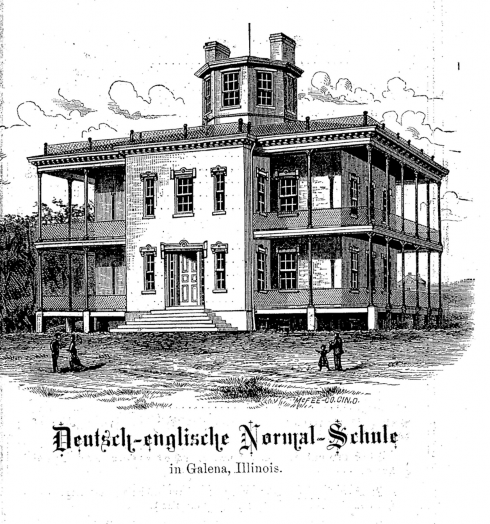
Figure 15. German-English Normal School. Note the small farmhouse in the background. Marine Hospital File - Galena-Jo Daviess County History Museum.
A pleasant description of the premises was offered by a reporter for the Gazette (9 November 1868). He described large and spacious rooms that were well lit and well equipped. He even noticed that some rooms were fitted with Harswood's patent combination desks with moveable seats.
The first graduates from the Normal Department were awarded their degrees in 1871; normal schools had two-year programs for those pursuing teaching (Figure 16). All but one of the graduates were from Galena (Catalogue of the Northwestern German-English Normal School, 1875, Marine Hospital folder, State Historic Sites Office). But there was also an Academic Department for those hoping to go on to a four-year college, and also a Preparatory Department for those too young or not ready for the higher departments.
Courses were taught in both English and German. As the years passed, English was used more than German (Figure 17).

Figure 16. Early Diploma from North-Western German-English Normal School - 1876. Terry Miller Facebook image.

Figure 17. Students from the German-English School having picnic at base of stairs leading up the hill to the school. Alfred W. Mueller Collection - Galena State Historic Sites Office.
There was no on-campus housing, such as a boarding hall, so students without family nearby had to board with someone in town. This meant everyone did a lot of walking. To improve the situation, and to shorten the walk a little, school volunteers began to improve Park Avenue (then second street) from its terminus at the Henry Corwith home (now the Belvedere Mansion) to the foot of the stairs leading up to the school. But not everyone was pleased: "We learn that some of the people of that neighborhood called on some members of the City Council yesterday and objected to the improvement, though for what reason we cannot understand" (clipping dated 10 October 1873, Marine Hospital folder, State Historic Sites Office). The mayor and majority of the council, however, authorized the work to proceed (Figure 18).

Figure 18. German-English Normal School- students studying on grounds - circa 1885 - Alfred W. Mueller Collection - Galena State Historic Sites Office.
But the problem of ease of access remained. The Gazette reported in December of 1882 that a new sidewalk had been built from the home of Madison Y. Johnson (who had purchased the home of Henry Corwith when the latter moved to Chicago) to the German- English school (1 December 1882). But the trustees, noting that they had been in operation for 15 years, suggested that it would be difficult for them to remain in Galena without assistance from the city. Another difficulty was the access road, which during times of high water was impassable. A new one was needed but the city seemed unwilling to commit any real resources to the problem (Figure 19).

Figure 19. College Faculty German-English College for 1889-1890 - Rev. Fr. Schaub, A. M., President, Mathematics and Commercial Work. Rev. F. E. Hirsch, A. B. German and Ancient Languages. Miss Carrie L. Schulz, Elementary German and Second Year's Sciences. Rev. E. E. Schuette, Theology. Prof. Geo. M. Hewey, B. L., English Language and Normal Work. Miss Etta M. Berryman, Preparatory Branches. Miss Ada Bachelor, Instrumental Music. Galena Daily Gazette, 9 August 1889 - Courtesy of Tim Doser.
Demand for a four-year degree led the school to incorporate as a college in 1881, thus permitting the issuance of four-year degrees (Figure 20). The name changed to the German-English College (Catalogues of the German-English College for the years 1889-
1890 and 1890-1891, Marine Hospital folder, State Historic Sites Office). The catalogs for the later years carried large amounts of advertising from area businesses, and many in Galena thought all was well, especially as tuition remained low (Figure 21).

Figure 20. Advertisement for catalog of the German-English College for 1888.
Galena Daily Gazette, 24 August 1888.

Figure 21. Receipt for German-English College tuition for George Avery - 1890. Terry Miller Facebook image.
But suddenly the ads for the 1890-1891 catalog were mostly from Charles City, Iowa. The Board of Trustees had determined that it was time to move. Increasing enrollments and a building too small--and difficult to access--were contributing factors. Some of the trustees felt that the old hospital had been remodeled for a purpose that it was never--and never could be--well adapted to (Catalog for 1890-91, pp. 5-6).
High water from the Galena river remained a threat to ease of access. And finances had been particularly difficult, with funds coming from tuition and donations from the Conference. It was felt that an addition to their building was needed, but there was no funding available. They also felt the need to be closer to the residential part of town, for the ascent up the hill to the school placed "too severe a strain upon many students, especially ladies" (Catalog for 1890-91, p. 6).
Over time, demand for such a school was coming increasingly from Iowa, and a more centralized location was also thought advantageous. The Trustees had come to the conclusion "that the location of the College at Galena was never a happy one." They voted to solicit bids from Iowa towns for new facilities. When Charles City, Iowa made an offer of $30,000 cash, a campus, and free use of city water for ten years, a majority of the trustees jumped at the offer. The new campus would open for the Fall, 1891 semester ((Catalog for 1890-91, pp. 5-6). The old Marine Hospital was once again in limbo.
An Uncertain Future
The 31 August 1894 The Galena Daily Gazette announced that Michael O. Reilly:
"has bought of Mrs. Eva Barbara Brunner the old Brunner homestead at the foot of Park avenue for $1015. Mr. Reilly recently bought the old German- English school building ....he expects to convert it into a residence for summer use, while his newest acquisition he will retain as a winter home."
The 12 July 1894 issue had reported that he purchased the Marine Hospital for $1500.
He purchased the entire property which included 11 acres, but the building, which had not been occupied since 1892, was said to be in a "badly dilapidated state" (Daily Gazette 11 July 1894). If Reilly and his wife lived there it was only for a short time; his residence in the 1900 City Directory listed him as living at 1105 Third Street.
The 5 October 1910 issue of the Daily Gazette quoted a letter to the editor from Mrs. Reilly:
I see that a member of the commercial club suggests that the city purchase the old Marine Hospital. Mr. Reilly, before his death, said he would like to see the hospital here. Please state that I would sell the property reasonably and help this cause along in any way I could, as I want to see Mr. Reilly's wish fulfilled.
Unfortunately for Mrs. Reilly, it didn't happen. From 1912 to 1933 it was used as a home for the F. A. Nash Medical Company (Galena Daily Gazette, 21 September 1956). A headline in the 9 December 1911 issue of the Daily Gazette announced in bold letters:
Medical Factory Assured
The chairman of the Industrial Committee of the Commercial club, in conjunction with Mr. Frank Nash of Hanover, completed the canvass for 120 shares of stock at $10 each for the establishment of the medical factory at the Normal school...
All 120 shares were sold.
Frank Nash over the years got involved with medical supplies and several other things, one of which was the Nash Sanitarium, a place for long-term care patients, often those with tuberculosis. But patients with other diseases and injury were also accepted. A notice in the paper in 1918 announced that John Duggan of Vinegar Hill had died at the sanitarium after a long illness (Galena Daily Gazette, 21 February 1918).
Nash also opened up a picnicking and camping site for auto tourists and others who could have a beautiful view of Galena while enjoying the tree-shaded grounds. An ad in 1927 played up the benefits of the "Nash Park Tourist Camp" with baths and "the best view of Galena" (Galena's Century Milestone: 1826-7 -- 1926-7, p. 48). Everyone was invited to have their picnics and gatherings at the site (Figure 22).

Figure 22. Nash Park Tourist Camp. 1927 ad from Galena's Century Milestone, by Florence Gratiot Bale - reprinted by Terry Miller.
Nash held onto the property until 1941, having purchased it in December, 1911 for slightly less than $900 (Book of Deeds #99, p. 398). During the Great Depression (1929- 1941) it appeared that the property languished. Any residents were apparently renters or caretakers. But in August of 1941 a news piece announced "Normal School Property Sold:"
-
A. Nash has sold the property known as the Normal School to Mrs. Leta Christen who will make this her home, and also after the building is newly decorated and modern conveniences installed, will serve chicken dinners and light beverages and ice cream to the public. It is planned to improve the grounds and make an up to date picnic grounds which can be used for family reunions and picnics. (Galena Daily Gazette, 1 August 1941.)
This enterprise was short-lived, perhaps due to the coming of World War II only four months later. The next occupants were William and Leila Brownell who had been operating a small nursing home in nearby Platteville, Wisconsin. They had already purchased the Nelson Stillman mansion in 1944 (Book of Deeds #126, p. 354) for a new and larger nursing home. Only a few years later they purchased the old Marine Hospital. A notice in the Galena Advertiser in 1950 announced a picnic to be held at the site:
Members of the V.F.W. Auxiliary...met at the Boyd store Thursday evening and were transported to Idle Acres, the home of Mr. and Mrs.
W. H Brownell, where they enjoyed a picnic potluck and a social evening.
Mrs. Brownell took them on a tour of the building and grounds, which she has purchased and remodeled, and opened to the public as a summer resort and hotel.
Idle Acres, now easily accessible on a modern road, consists of...some of the most scenic grounds in this vicinity, and riding horses and other recreational facilities have been provided for the ten to twenty guests who can be accommodated. (Galena Advertiser, 20 July 1950.)
Near tragedy struck, however, only three months later when the paper reported a large barn fire:
A combination tool shed and barn, about 20 by 30 feet, was destroyed by fire Tuesday afternoon on the Idle Acres Farm... The fire had complete control when the fire department was summoned, but firemen kept the flames from spreading to the main building nearby. (Galena Advertiser, 19 October 1950.)
But for unknown reasons (perhaps the time and financial demands of the Brownell Nursing Home (Stillman mansion) the Brownells sold the property in April of 1951 to
Lloyd and Grace MacBeth (Book of Deeds #136, p. 505). Grace MacBeth had borrowed over $5,000 from a private party to purchase and make a few upgrades to the property.
But only a year later the property was again on the market, probably for financial reasons, but didn't sell.
A realtor's ad described a "romantic old brick mansion" with a 34 foot living room, lavatory and shower on the first floor" and a full bath on the second. The building also featured eight fireplaces (Figure 23). The ad did note, however, that some repairs were required on the exterior "to put this property in condition for use as a rest haven, old folks home, school, hospital, club, summer resort or dwelling (Galena Advertiser, 30 June 1952). The description might have painted a rosier picture than was the case (Figure 24).

Figure 23. Marine Hospital showing one of original fireplaces. Neg. 7 Galena State Historic Sites Office.

Figure 24. Back of Marine Hospital when privately owned during early 1950s Marine Hospital file. Galena State Historic Sites Office.
Grace was unable to repay the loan. The paper reported that she was "reputed to have kept a large number of dogs about the place" (Galena Daily Gazette, 21 September 1956). Irrespective of the dog problem, she was also falling behind on her property taxes, which ultimately resulted in a sheriff's sale (Master's Deed Instrument #75123, 16 March 1955). The sole and successful bidder was Gus Papke of Dubuque, Iowa. He was the private party who had loaned Mrs. MacBeth the $5,418.32 to buy and improve the property. At this time the building still had its belvedere, or cupola, and beautiful porches around the exterior.
Papke wanted to recoup his investment. He determined that turning the building into apartments was the way to do it. His first order of business was to remove the cupola and then the porches:
Recently he decided that the building could profitably be turned into living quarters. He took the cupola down last week and is now removing much of the superstructure preparatory to re-covering the building with a flat-type roof. He also plans to remove the old porches. (Galena Daily Gazette, 21 September 1956.)
A front page picture in the Gazette article showed workmen atop the roof tearing down the last of the cupola (Figure 25). An "Architectural Survey Inventory" of Galena's buildings completed in 1964 by the State of Illinois described the alterations this way: "cupola & original porch shamelessly removed" (Marine Hospital file at the Galena State Historic Sites Office). Upon project completion, there were to be six three or four room flats (undated clipping in the files of the Galena-Jo Daviess County History Museum).
The magnificent iron staircase, which ran from the basement floor all the way to the cupola, was torched off at the top to accommodate the changes.
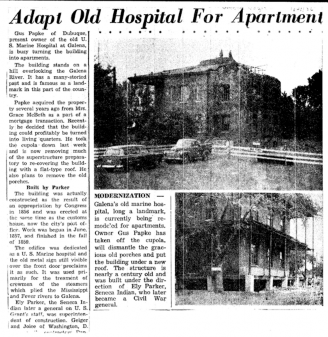
Figure 25. Cupola being removed from Marine Hospital. Galena Gazette, 21 Sept. 1956.
Gus Papke's project was never completed. Perhaps it was a lack of financing, or enthusiasm, but for whatever reason, the building entered another period of neglect. A letter from the National Trust for Historic Preservation dated March 1, 1968 stated that it was a "handsome building" but it was "unfortunate that appropriate action to save the structure was not initiated in time (Marine Hospital file at the Galena State Historic Sites Office).
The property was purchased by Chicagoans Jack Stevens and Phillip Humphries during this time, but again, little happened. They, in turn, sold everything to John and Adelaide Clark in 1969 (Warranty Deed #122798). But once again, the novelty wore off--or the money gave out--and they sold the property to Lee and Louise Kent in 1971. The Kents, from Evanston, IL were more serious and focused in their approach.
A Galena Gazette article in 1977 reported the Kents hoped to put the old Marine Hospital on the annual Tour of Historic Homes. They were reportedly facing "the years of renovation ahead with enthusiasm" and had even engaged the services of an architect for the project (Galena Gazette, 22 September 1977). They were planning on putting a scaled down cupola back on the roof (Figure 26). They had already put in a central heating system and new plumbing. The remainder of the old corrugated iron roofing was also replaced.

Figure 26. Marine Hospital looking northeast with new scaled-down cupola added in the 1970s. 2017 photo by Ken Robb.
But like so many before them, their effort faltered and a quit claim deed in the Jo Daviess County Courthouse pretty well summed it up: THE GRANTOR, Lee F. Kent, divorced and not since remarried...CONVEY and QUIT CLAIM to Louise E. Kent..." the old Marine Hospital (Quit Claim Deed #184083, February 3, 1987). The property was immediately listed for sale by local realtor Ralph Benson:
Possibly the only Marine hospital still standing in the State of Illinois... imposingly located on a high bluff overhanging the Galena River... The
grounds are extensive and capable of cultivation and great ornamentation... Three levels connected by a magnificent winding Whale encrested [sic]Wrought Iron stairway. The lower level has been completely remodeled into living quarters, brick floors, modern kitchen, new heating system. (Galena Gazette, 20 May 1987.)
Before the year was out, Louise Kent sold the property to Robert Farster (Quit Claim Deed #188481, October 29, 1987), who immediately turned it over to the Sangamon Packet Company.
The Sangamon Packet Company was the creation of Dennis Trone and his brother, who had been running tourist excursion boats on the Illinois River and elsewhere. An experienced river pilot and lover of river history, Trone brought up two boats to run between Chestnut Mountain Ski Resort and LeClaire, Iowa, just north of the Quad Cities. One was the Julia Belle Swain, a modern design steam vessel, and the other was the diesel-powered Twilight, both paddle wheelers (personal knowledge of Daryl Watson, who had the privilege of knowing Trone for a number of years). The Marine Hospital became, at times, his home away from home during the boating and tourist season.
But six years later, Trone's corporation sold the property to Mary Alice Bernard, Terry Fisher and Carolyn Dodds (Corporation Warranty Deed #225243, July 30, 1993). This was a serious group that really wanted to restore the building. They needed, however, to come up with a plan that would make it economically feasible. With the Marine Hospital and 11 acres to work with, the group envisioned a resort as being the best option. The hospital would have to accommodate ten units plus a manager's apartment in a 6,500 square foot building (North Western Gazette, 30 July 1993).
There was only one problem--the Galena zoning ordinance. It called for any resort developments to be located on a minimum of 50 acres. And Bed and Breakfast homes, another option, were restricted to a maximum of five units. Also, there would have to be a rezoning to auto-oriented from agriculture--and there was no good auto access to the Marine Hospital. Five neighbors all opposed the request. The zoning board rejected the application (North Western Gazette, 30 July 1993), leaving everything up in the air.
The group continued to explore options and hosted a number of events at the Hospital to showcase its importance and potential. Perhaps the largest was an open house for anyone interested in the history and future of the Hospital. It was held one evening in September and over 200 people attended (North Western Gazette, 10 September 1993). Comments were favorable but no one stepped forth with a workable plan on how to move forward.
The effort faltered and then fell apart. Terry Fisher and Carolyn Dodds quit claimed their share to Mary Alice Bernard (Deed Instrument #242455, 11 January 1996) who then sold the property to Frank Budreck of Libertyville, Illinois the same day (Deed #242456).
Budreck has maintained the property since that time but has had it on the market for a number of years. As of November, 2020 he appeared to have a buyer.
Conclusion
Galena's Marine Hospital, completed in 1859, is one of Galena's most historic buildings. It has not only local and regional significance but also national significance. It represents the first effort by the U. S. federal government to take care of the needs of sailors and boatmen from 1798 onward. It was funded in part with a deduction from every employee's wages of twenty cents per month. The rest was picked up by the federal government. Given the importance and reliance of the new nation on goods and services provided by rivers, lakes and ocean commerce, few complained.
Prior to the Civil War, roughly thirty marine hospitals were constructed, most along the East Coast, but then increasingly along inland rivers and lakes. Of the latter, only the hospitals at Louisville and Galena remain. (See Appendix A) Unfortunately for the Galena hospital, it was never able to realize its full potential. A civil war, a silting up little stream, railroads, and changing trade and commercial patterns conspired against the effort. It lasted only six years, treating relatively few patients during that time.
Sadly, Galena's Marine Hospital has been on an up and down ride ever since, mostly down. It has been plagued by good but ineffective intentions from its first days right down to the present. Lack of maintenance and misdirected alterations have occurred; the worst coming in the 1950s when the cupola, or belvedere, along with the porches were removed entirely from the structure. Given the complexity of construction and coherence of design, one might as well have let an auto mechanic touch up the Mona Lisa.
The Hospital was named to Landmarks Illinois' annual Ten Most Endangered Historic Places list in 2014 (Galena Gazette, 9 April 2014). In naming the structure to its Ten Most list, the organization hoped that it would help in "finding a viable plan for its rehabilitation and reuse." After 160 years, that remains the hope. (Figure 27.)

Figure 27. Back of Marine Hospital looking west -landmark building still awaiting restoration. 2017 photo by Ken Robb.
Acknowledgements
In 2019, The Galena Foundation initiated an effort to publicize the plight of a number of historic properties in town that were in danger of disappearing. One of the results of their efforts was a report on the history and condition of the McGovern-Delihant House located at 901 Fourth Street. This report on the old Marine Hospital deals with a different type of building, one that started out as a federal property in 1859 and six years later fell into private hands. But the story has many similarities and many people helped in the compilation of this history.
In no particular order, thanks go to Karen Zehr and the Recorder's Office at the Jo Daviess County Courthouse. She made quick work of tracking down (or showing how to find) deeds and property transactions over a 160 year period. The Galena-Jo Daviess County Historical Society was also very helpful, and special thanks go to volunteer Chris Chapman, who helped scour their collections for information on the Marine Hospital. An even more serious mention must be made of the Historical Collections Room at the Galena Public Library. Their materials are always critical to a report such as this. They have an incredibly dedicated group of local historians: historical librarian Steve Repp helped whenever and wherever he could. Help was also received from volunteers Tim Doser, Craig Albaugh, and Dale Glick, who went out of their way to provide pertinent leads on the Hospital. Craig's efforts in collecting for the library digital copies of early Galena photographs is nothing short of remarkable. And Tim kept providing old newspaper articles--and photographs--too numerous to mention.
The City of Galena staff also offered valuable assistance, particularly Building Inspector Jonathan Miller with his building department files. And thanks also to various individuals, to numerous to mention, who helped with various leads and bits of information. And special thanks to Galena Foundation Board member Beth Baranski who helped at various points along the way, most especially with the final phase of proofing, editing and printing.
Special mention must be given to the Galena State Historic Sites Office and site manager Terry Miller and curator and interpreter Jamie Loso. They had by far the most voluminous files and photos on the Hospital and gladly gave access to them all. Their help was invaluable to the final report.
But most of all, a huge thanks to the Galena Foundation and all of its directors for believing in Galena and the value of each and every bit of its history and architecture.
Daryl Watson, Historical Researcher
Appendix A
